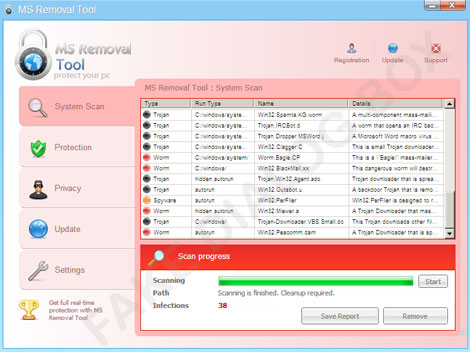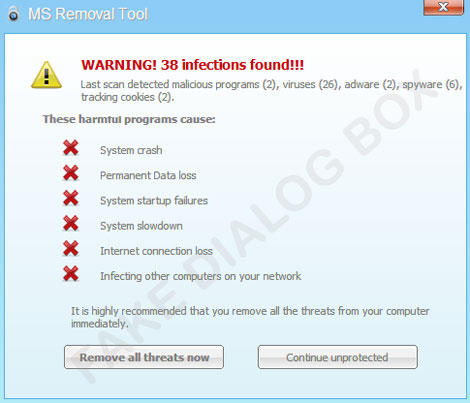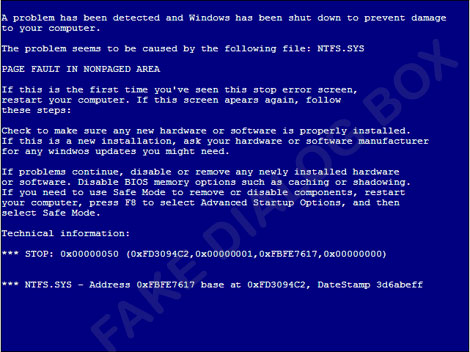TROJ_FAKEAV.BSTA
Symantec : Trojan.FakeAV ; Microsoft : Rogue:Win32/Winwebsec
Windows 2000, Windows XP, Windows Server 2003


Threat Type: Trojan
Destructiveness: No
Encrypted: Yes
In the wild: Yes
OVERVIEW
This Trojan displays fake alerts that warn users of infection. It also displays fake scanning results of the affected system. It then asks for users to purchase it once scanning is completed. If users decide to purchase the rogue product, users are directed to certain sites asking for sensitive information, such as credit card numbers.
This Trojan may be unknowingly downloaded by a user while visiting malicious websites.
TECHNICAL DETAILS
Arrival Details
This Trojan may be unknowingly downloaded by a user while visiting malicious websites.
Installation
This Trojan drops the following files:
- %System Root%\fsqwr.bmp - non-malicious fake alert image file
- %System Root%\Documents and Settings\All Users\Application Data\{random}\{random} - non-malicious file
(Note: %System Root% is the root folder, which is usually C:\. It is also where the operating system is located.)
It drops the following copies of itself into the affected system:
- %System Root%\Documents and Settings\All Users\Application Data\{random}\{random}.exe
(Note: %System Root% is the root folder, which is usually C:\. It is also where the operating system is located.)
It creates the following folders:
- %System Root%\Documents and Settings\All Users\Application Data\{random}
(Note: %System Root% is the root folder, which is usually C:\. It is also where the operating system is located.)
Autostart Technique
This Trojan adds the following registry entries to enable its automatic execution at every system startup:
HKEY_CURRENT_USER\Software\Microsoft\
Windows\CurrentVersion\RunOnce
{random} = %System Root%\Documents and Settings\All Users\Application Data\{random}\{random}.exe
NOTES:
It displays fake alerts that warn users of infection. It also displays fake scanning results of the affected system. It then asks for users to purchase it once scanning is completed. If users decide to purchase the rogue product, users are directed to the following sites asking for sensitive information, such as credit card numbers:
- http://{BLOCKED}.{BLOCKED}.194.43/
- http://{BLOCKED}.{BLOCKED}.194.173/
It displays the following fake alerts:




It also prevents executable files from executing. It displays the following fake alert whenever the an infected user tries to execute files:

It does not avoid terminating Windows processes.
SOLUTION
Step 1
For Windows XP and Windows Server 2003 users, before doing any scans, please make sure you disable System Restore to allow full scanning of your computer.
Step 2
Restart in Safe Mode
Step 3
Search and delete these folders
Step 4
Search and delete this file
Step 5
Delete this registry value
Important: Editing the Windows Registry incorrectly can lead to irreversible system malfunction. Please do this step only if you know how or you can ask assistance from your system administrator. Else, check this Microsoft article first before modifying your computer's registry.
- In HKEY_CURRENT_USER\Software\Microsoft\Windows\CurrentVersion\RunOnce
- {random} = %System Root%\Documents and Settings\All Users\Application Data\{random}\{random}.exe
- {random} = %System Root%\Documents and Settings\All Users\Application Data\{random}\{random}.exe
Step 6
Restart in normal mode and scan your computer with your Trend Micro product for files detected as TROJ_FAKEAV.BSTA. If the detected files have already been cleaned, deleted, or quarantined by your Trend Micro product, no further step is required. You may opt to simply delete the quarantined files. Please check this Knowledge Base page for more information.
Did this description help? Tell us how we did.

